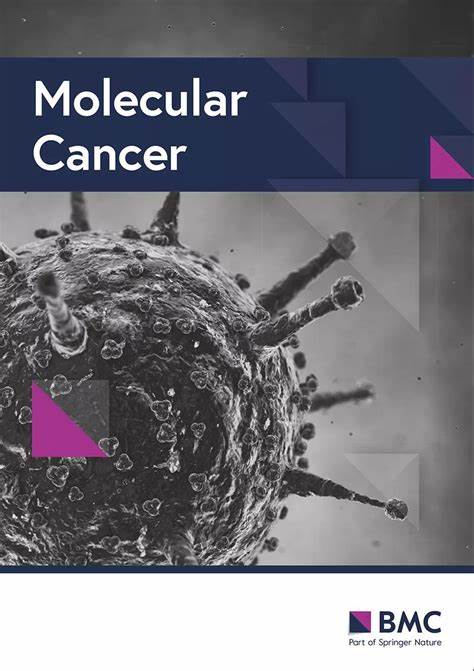EIF4E-mediated biogenesis of circPHF14 promotes the growth and metastasis of pancreatic ductal adenocarcinoma via Wnt/β-catenin pathway
IF 27.7
1区 医学
Q1 BIOCHEMISTRY & MOLECULAR BIOLOGY
引用次数: 0
Abstract
CircRNAs are critically involved in the development and progression of various cancers. However, their functions and mechanisms in pancreatic ductal adenocarcinoma (PDAC) remain largely unknown. CircPHF14 (hsa_circ_0079440) was identified through the analysis of RNA sequencing data from PDAC and normal adjacent tissues. The biological functions of circPHF14 were then evaluated using CCK8, EdU, transwell, colony formation, wound healing assays, as well as pancreatic orthotopic xenograft and liver metastasis models. The interaction mechanisms between circPHF14 and PABPC1, which enhance the stability of WNT7A mRNA, were investigated through RNA pull-down, mass spectrometry, RNA Immunoprecipitation (RIP), and actinomycin D assays. The role of EIF4E in promoting circPHF14 biogenesis was examined using RIP, and western blotting. In this study, we observed a significant upregulation of circPHF14 in both clinical PDAC samples and cell lines. Functionally, circPHF14 enhanced PDAC proliferation and metastasis both in vitro and in vivo. Mechanistically, circPHF14 interacted with PABPC1 to stabilize WNT7A mRNA, thereby activating the Wnt/β-catenin pathway, which subsequently upregulated SNAI2 and initiated Epithelial-Mesenchymal Transition (EMT) in PDAC. Additionally, EIF4E was found to bind PHF14 pre-mRNA, facilitating circPHF14 biogenesis. Finally, we developed a lipid nanoparticle (LNP) formulation encapsulating sh-circPHF14 plasmids and confirmed its anti-tumor efficacy in a patient-derived xenograft (PDX) model. EIF4E-mediated biogenesis of circPHF14 stabilizes WNT7A mRNA via interaction with PABPC1, which subsequently activates the Wnt/β-catenin pathway, promoting the growth and metastasis of PDAC. These findings indicate that circPHF14 holds promise as a biomarker and therapeutic target for PDAC.eif4e介导的circPHF14生物发生通过Wnt/β-catenin通路促进胰腺导管腺癌的生长和转移
circrna在各种癌症的发生和发展中起着至关重要的作用。然而,它们在胰腺导管腺癌(PDAC)中的功能和机制仍不清楚。CircPHF14 (hsa_circ_0079440)是通过分析PDAC和正常邻近组织的RNA测序数据鉴定出来的。然后通过CCK8、EdU、transwell、菌落形成、伤口愈合试验以及胰腺原位异种移植和肝脏转移模型来评估circPHF14的生物学功能。通过RNA拉下、质谱、RNA免疫沉淀(RIP)和放线菌素D检测,研究了circPHF14和PABPC1增强WNT7A mRNA稳定性的相互作用机制。利用RIP和western blotting检测EIF4E在促进cirphf14生物发生中的作用。在这项研究中,我们在临床PDAC样本和细胞系中观察到circPHF14的显著上调。在功能上,circPHF14在体内和体外都增强了PDAC的增殖和转移。在机制上,cirphf14与PABPC1相互作用以稳定WNT7A mRNA,从而激活Wnt/β-catenin通路,随后上调SNAI2并启动PDAC的上皮-间质转化(Epithelial-Mesenchymal Transition, EMT)。此外,EIF4E被发现结合PHF14 pre-mRNA,促进cirphf14的生物发生。最后,我们开发了一种脂质纳米颗粒(LNP)制剂,包封了sh-circPHF14质粒,并在患者来源的异种移植(PDX)模型中证实了其抗肿瘤功效。eif4e介导的circPHF14通过与PABPC1的相互作用稳定WNT7A mRNA,进而激活Wnt/β-catenin通路,促进PDAC的生长和转移。这些发现表明circPHF14有望成为PDAC的生物标志物和治疗靶点。
本文章由计算机程序翻译,如有差异,请以英文原文为准。
求助全文
约1分钟内获得全文
求助全文
来源期刊

Molecular Cancer
医学-生化与分子生物学
CiteScore
54.90
自引率
2.70%
发文量
224
审稿时长
2 months
期刊介绍:
Molecular Cancer is a platform that encourages the exchange of ideas and discoveries in the field of cancer research, particularly focusing on the molecular aspects. Our goal is to facilitate discussions and provide insights into various areas of cancer and related biomedical science. We welcome articles from basic, translational, and clinical research that contribute to the advancement of understanding, prevention, diagnosis, and treatment of cancer.
The scope of topics covered in Molecular Cancer is diverse and inclusive. These include, but are not limited to, cell and tumor biology, angiogenesis, utilizing animal models, understanding metastasis, exploring cancer antigens and the immune response, investigating cellular signaling and molecular biology, examining epidemiology, genetic and molecular profiling of cancer, identifying molecular targets, studying cancer stem cells, exploring DNA damage and repair mechanisms, analyzing cell cycle regulation, investigating apoptosis, exploring molecular virology, and evaluating vaccine and antibody-based cancer therapies.
Molecular Cancer serves as an important platform for sharing exciting discoveries in cancer-related research. It offers an unparalleled opportunity to communicate information to both specialists and the general public. The online presence of Molecular Cancer enables immediate publication of accepted articles and facilitates the presentation of large datasets and supplementary information. This ensures that new research is efficiently and rapidly disseminated to the scientific community.
 求助内容:
求助内容: 应助结果提醒方式:
应助结果提醒方式:


